
(Photo: Heading up pitch 2 of Son of Bitchy Virgin (5.6))
Good judgment.
It is important to have good judgment when climbing. As a leader, I hope I have it. It is important to me to think that I have it. Thinking I have it is probably almost as important to my leading as actually having it.
As I've edged back into pushing my limits this year, I've tried to be cautious. But I know enthusiasm can at times threaten my good judgment. And I have a lot of enthusiasm.
My friend and longtime climbing partner Liz is having a baby in the fall. She has continued climbing (though not leading anything) during her pregnancy. She was with me on Apoplexy (5.9) earlier this year, for example. As her pregnancy has progressed she's gradually been forced to accept that she has to dial it back to easier climbing. But she hasn't given up without a fight. She gamely followed me up Birdland (5.8) in May even though she struggled with the cruxes of both pitches. On another occasion, climbing not with me, she had to prussik through the crux while following Modern Times (5.8+).
I was looking for partners while I was in New Paltz for the week before July 4 with my family, so I was excited Liz was thinking about joining us. I didn't want to put either of us in a dangerous situation given that she was now about halfway through her pregnancy. So I promised her that if she joined us at our summer house in New Paltz in early July, I wouldn't push her to do anything hard. We could focus on 5.6 and below, which we felt would be easy and casual for both of us.
My first idea was that we should do the Bitchy Virgin climbs. I had never done them. The original route, Bitchy Virgin, has two pitches of 5.5, and the successor Son of BV ups the ante slightly with one pitch of 5.5 and a second that is 5.6. In between is a variation single-pitch climb called Immaculate Conception (also 5.6) which ends at the Son of BV anchor. If we did them all we'd get 5 pitches done in this one little spot. Liz hadn't tried these climbs either so she agreed.
When we arrived at the base of the climbs, I thought Immaculate Conception looked like the most interesting line. A couple steep moves past some suspect flakes about 15-20 feet up seemed like the crux.
Once we racked up, I enjoyed it. The crux steep bit past the flakes leads over a bulge to easier climbing at a lower angle. The flakes are creaky but I don't think they're popping out any time soon. Once over the bulge there is a little bit of a runout to the belay ledge, but this runout is through territory much easier than 5.6. At the belay ledge there is a station made from slings threaded around a boulder, but I elected to build a gear anchor in the good cracks right above the ledge instead, so we could both comfortably stand on the ledge and belay with the anchor above our hands.
If our first pitch, Immaculate Conception, was nice, pitch two of Son of BV was really quite nice indeed. The climb goes straight up, trending a little left. It is nothing but good face climbing. Clean, steep and sustained, with good moves and good holds. I have seen reports of inadequate pro, but I thought the pro was just good enough. The horizontals appear every so often, and I even passed up an opportunity or two to place something a little off line to the left and the right. This is definitely not a pitch that you can sew up, however, and if 5.6 is your lead limit this climb might not be the best one for you. With that caveat aside, I would say Son of BV is yet another high quality 5.6 in the Gunks, worth the two stars Dick bestows upon it (when linked with Immaculate Conception) and further evidence that 5.6 is one of the great grades at the Gunks.
The rap tree on the GT Ledge at the top of Son of BV bears watching. This muti-forked tree has some live branches, and some that are dead or dying. It has seen better days. We went ahead and used it, because it didn't look like it would be that easy to get over to the much bigger and healthier-looking tree atop Bitchy Virgin. Pretty soon, unless the tree atop Son of BV recovers a bit, we may not have a choice. I have seen worse rap trees in the Gunks, but I think at another time in my climbing life I would have insisted we use a different station to get off the cliff. It may be that I have mellowed a bit when it comes to using these sketchy rap anchors, and I'm not sure this is a good thing. Perhaps we should not have used it.
Liz had no trouble following me up either of our first two 5.6 pitches, so I thought the two 5.5 pitches of Bitchy Virgin would be a breeze for her. It was getting hot out but neither of us were concerned. We didn't stop to take a break. Once we returned to the base I went right at pitch one of Bitchy Virgin.
The pitch climbs a corner at the back of a little gully that goes between the main cliff and the left side of the Mantle Block. I was surprised to find the Bitchy Virgin corner a little dirty. I didn't see much evidence of other climbers, either. This was in stark contrast to Immaculate Conception, the climb we'd just finished to the left, which had tons of chalk on it, even though all the nearby climbs were only recently reopened after the peregrine nesting that closes a portion of the cliff every year.
Is Bitchy Virgin unpopular? Dick Williams gives it a star. Perhaps it is the little scramble up the gully to the start that puts people off?
Whatever the reason, I think if people are taking a pass on Bitchy Virgin they are missing out. In my opinion it is good, and a bit stiff for 5.5. Nice moves go up the corner, using the crack at the back for pro and sometimes for upward progress. Eventually there is a somewhat awkward struggle past a tree (admittedly this part of the pitch isn't so great), after which you move a little further up the corner, almost to its top, before obvious holds take you on a fun, short traverse with good pro to the outside arete and around onto the main face, about 10 to 15 feet above the belay station for Immaculate Conception/Son of BV.
If I'm right that Bitchy Virgin isn't getting much traffic, I think that's an injustice. It is not a superclassic 5.5 like Horseman or Ursula, but I've done much worse one-star climbs in the Trapps. It is a totally worthwhile climb, and there aren't enough quality 5.5's out there for it to get so little attention, in my opinion.
Once I built us a belay, Liz had no trouble following the pitch. There was no sign of any problem. She came right up. Things were still going well.
So I set off on pitch two, having fun. It seemed a lot like pitch two of Son of BV, but easier. Clean steep climbing with good holds.
I was about twenty feet off the belay when Liz called up to me to say that she wasn't feeling well.
Uh oh.
I guessed that she was maybe feeling a little sick to her stomach.
I stopped and asked her a question. "Do you think you'll be able to finish this pitch?"
"No," she said. "I feel like I'm about to pass out!"
Crap. Not good.
Clearly we needed to get down. I immediately chastised myself for taking Liz up a multipitch climb. She hadn't had any fainting episodes on the rock before, but it suddenly seemed patently unwise to have her belaying me 100 feet off the ground halfway through her pregnancy, in the bright sunshine, away from the food and water. What a stupid thing to do. Both of us should have known better.
I stepped down to the last piece of gear I had placed and thought about our options. Option one: I could place another piece or two and build an anchor from which she could lower me to the belay. This meant that we'd be leaving pieces behind, which of course was a secondary consideration but still something to think about. Also, what if she passed out while lowering me? She was tied in, so she wouldn't go anywhere, but what about me? I'd be falling through space. She was belaying me with a Cinch, which should lock off if she were to let go, but still... this was not an acceptable option. I supposed I could build an anchor, attach myself to it, then pull up the rope and rap. But this seemed very time-consuming. There had to be a better way.
Quickly I came up with option two: I could just downclimb back to her. This immediately seemed like the better idea. She'd keep me on belay, I wouldn't leave any gear, and if she lost consciousness I'd still be on the rock, and not relying solely on her Cinch to catch me. The climbing had so far been through easy territory and I was confident downclimbing would be no problem.
I racked my brain for another option, but these were the best I could come up with.
So I downclimbed the twenty feet back to her, going as fast as I reasonably could and all the while talking to her to make sure she was still with me. It didn't take long, and it seemed with each passing second that it was less likely she'd actually faint. Nevertheless I was relieved to get back to the belay and clip in.
Once we were together I lowered her from the belay ledge to the ground, and then I rapped off. Even as I lowered her it seemed that the crisis had passed, but it still made sense to go find some shade, have some fluids, and rest a bit.
On the ground we ate and drank and Liz soon felt better; we even resumed some single-pitch climbing after we took a break.
As crises go this wasn't a big one. No one actually lost consciousness. No one was hurt.
But still one can learn from these experiences.
Obviously some of our decisions could have been better that day. We probably should have made more of an effort to stay in the shade, and to take things slow. And while maybe we didn't have to rule out multipitch climbing completely, at the very least we should have brought up some food and water with us on the cliff. I think we were lulled into a certain complacency by the fact that the climbing was easy and things were going smoothly.
So we maybe should have been more careful not to get into the situation in which we found ourselves. With that said, I think we behaved reasonably when the issue emerged. And I think the decision I made to downclimb was the right one, under the circumstances. The most conservative thing to do would have been to build an anchor, leave the gear, and rap to Liz. That would have allowed me to descend to her without requiring any belaying from her. If the climbing had been more difficult this likely would have been the only reasonable choice. But since the climbing was so easy I think my decision to downclimb instead was correct; it was the less complicated solution and quicker as well.
Good judgment? I guess I'll give myself a B. Poor planning, but a decent recovery.
 The bags are indeed very similar, with the Korean Zimbale (left) being intentionally modeled upon the English Carradice (right), in response to the increasingly limited availability of Carradice bags. Because of the similarity of the two designs, it makes more sense to describe how the Zimbale bag differs from Carradice, rather than review it from scratch. A thorough review of the Carradice Barley is available here.
The bags are indeed very similar, with the Korean Zimbale (left) being intentionally modeled upon the English Carradice (right), in response to the increasingly limited availability of Carradice bags. Because of the similarity of the two designs, it makes more sense to describe how the Zimbale bag differs from Carradice, rather than review it from scratch. A thorough review of the Carradice Barley is available here. The Zimbale 7L bag is as handsome as the Carradice Barley and seems to be made with the same degree of quality. The stitching is excellent and the leather has a nice feel to it. The colours are slightly more saturated than on the Carradice: the fabric is a deeper and brighter green, and the leather is a darker and redder brown.
The Zimbale 7L bag is as handsome as the Carradice Barley and seems to be made with the same degree of quality. The stitching is excellent and the leather has a nice feel to it. The colours are slightly more saturated than on the Carradice: the fabric is a deeper and brighter green, and the leather is a darker and redder brown. Structurally, the Zimbale 7L bag differs from the Carradice Barley in several ways - the first being its folded long flap. The folded flap design allows the bag to expand when over-stuffed. Carradice offers this flap on some of its larger models, but not on the 8L Barley. Another difference is the Zimbale's two "D-rings" (those black plastic clips on the sides), that allow the attachment of a strap, so that the bag can be removed from the bike and worn over the shoulder.
Structurally, the Zimbale 7L bag differs from the Carradice Barley in several ways - the first being its folded long flap. The folded flap design allows the bag to expand when over-stuffed. Carradice offers this flap on some of its larger models, but not on the 8L Barley. Another difference is the Zimbale's two "D-rings" (those black plastic clips on the sides), that allow the attachment of a strap, so that the bag can be removed from the bike and worn over the shoulder. Finally, unlike Carradice, Zimbale has a closure system where the metal buckles are supplemented by an eyelet-and-rivet system (is there an official name for this?) that makes opening and closing the bag faster and easier.
Finally, unlike Carradice, Zimbale has a closure system where the metal buckles are supplemented by an eyelet-and-rivet system (is there an official name for this?) that makes opening and closing the bag faster and easier.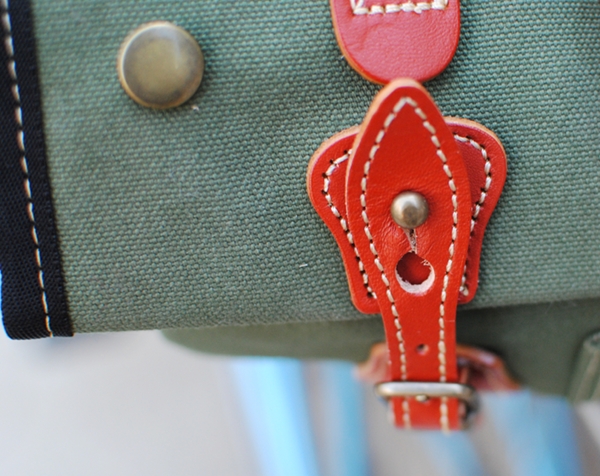 I must admit that the eyelet system is easier to use than the buckles. My only concern is that the leather in that area might fray over time - will see how it holds up in the long run.
I must admit that the eyelet system is easier to use than the buckles. My only concern is that the leather in that area might fray over time - will see how it holds up in the long run.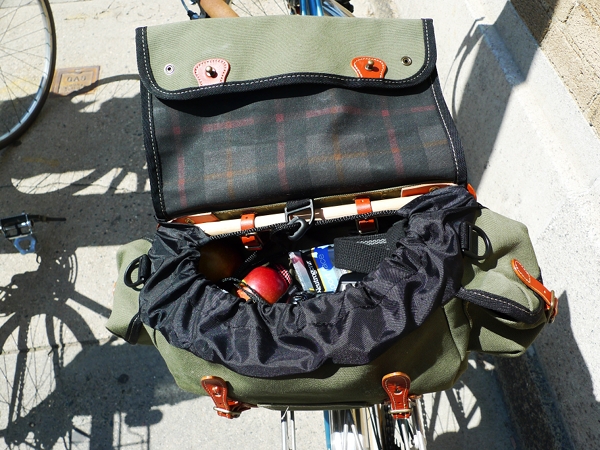 The inside of the bag is identical to Carradice, with the exception of the plaid lining of the top flap. The 7L Zimbale is just a tad smaller than the 8L Barley and this is more apparent when loading the bag than when looking at it. The next size up Zimbale offers is 11L, and that is the size I would get for proper touring. For shorter trips though, the 7L is sufficient.
The inside of the bag is identical to Carradice, with the exception of the plaid lining of the top flap. The 7L Zimbale is just a tad smaller than the 8L Barley and this is more apparent when loading the bag than when looking at it. The next size up Zimbale offers is 11L, and that is the size I would get for proper touring. For shorter trips though, the 7L is sufficient. One final thing to note about the Zimbale, is that the loop we like to use for tail light attachment is positioned higher than on the Carradice, reducing its suitability for this function. When the longflap is folded under, the tail light placement is okay. But when the flap needs to be expanded, the light points up and can no longer be mounted in that position. This has reminded me that we really need lights that mount on fenders - saddlebags just aren't ideal mounting points.
One final thing to note about the Zimbale, is that the loop we like to use for tail light attachment is positioned higher than on the Carradice, reducing its suitability for this function. When the longflap is folded under, the tail light placement is okay. But when the flap needs to be expanded, the light points up and can no longer be mounted in that position. This has reminded me that we really need lights that mount on fenders - saddlebags just aren't ideal mounting points.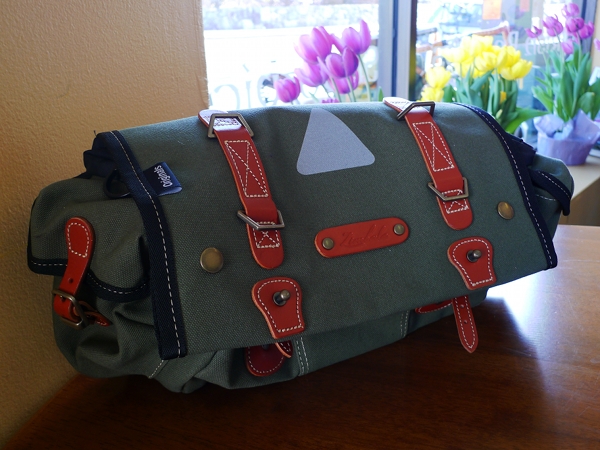 Overall, I like the Zimbale 7L bag as much as the Carradice Barley. I am at once uneasy about Zimbale's copying Carradice and grateful that more of such bags are being offered. Origin8 is also copying the Carradice design (in black only) with its "Classic Sport Saddle Bag" - so clearly there is a great deal of demand for such bags. For additional reviews of the Zimbale bags, see EcoVelo and Suburban Bike Mama.
Overall, I like the Zimbale 7L bag as much as the Carradice Barley. I am at once uneasy about Zimbale's copying Carradice and grateful that more of such bags are being offered. Origin8 is also copying the Carradice design (in black only) with its "Classic Sport Saddle Bag" - so clearly there is a great deal of demand for such bags. For additional reviews of the Zimbale bags, see EcoVelo and Suburban Bike Mama.











 When describing what we like or dislike about riding a particular bike, we speak of that bicycle's "ride quality". But what exactly is that? In simple terms, it's how a bicycle feels to ride. Is it comfortable? how does it feel over bumps? how does it accelerate? how does it behave when turning corners? how does it feel when loaded? At least to some extent, all of the descriptions we provide under the umbrella of "ride quality" are subjective. And although there are objective, technical factors underlying the subjective experiences, the relationship between these factors is so complex and so sensitive to even the most minuscule variations, that translating sensations into explanations can be tricky.
When describing what we like or dislike about riding a particular bike, we speak of that bicycle's "ride quality". But what exactly is that? In simple terms, it's how a bicycle feels to ride. Is it comfortable? how does it feel over bumps? how does it accelerate? how does it behave when turning corners? how does it feel when loaded? At least to some extent, all of the descriptions we provide under the umbrella of "ride quality" are subjective. And although there are objective, technical factors underlying the subjective experiences, the relationship between these factors is so complex and so sensitive to even the most minuscule variations, that translating sensations into explanations can be tricky.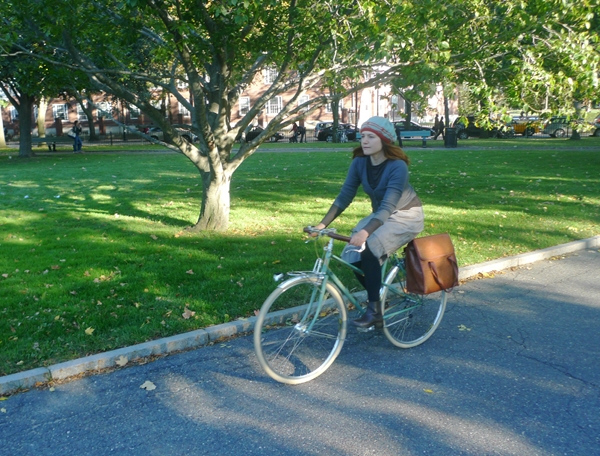 This is especially true of my Royal H. mixte. Its ride quality intrigues me, because it is like nothing I have experienced before. For one thing, the frame feels oddly soft and springy. Some may suggest it's the tires, but no - the sensation is from the actual metal. It's like riding a bike carved out of a cloud, and the feeling is the exact opposite of the vintage Motobecane I used to own - whose frame felt "painful" and "hard". The other mysterious aspect of the Royal H., is the extent to which it likes to keep its line of travel. You can launch this bicycle across a room without a rider, and it will go straight. When I turn a corner, it goes at the exact trajectory I want it to go. I have never experienced anything quite like it. I know that Bryan (the framebuilder behind Royal H.) chose a delightfully eccentric combination of tubing specifically to combat the discomfort issues I was having with my vintage mixte, and that he built the bicycle with neutral trail so that it would feel stable. But is it really as simple as that? I have ridden other bicycles with good tubing and neutral trail, and they did not handle quite like this. So I prefer to attribute it to magic.
This is especially true of my Royal H. mixte. Its ride quality intrigues me, because it is like nothing I have experienced before. For one thing, the frame feels oddly soft and springy. Some may suggest it's the tires, but no - the sensation is from the actual metal. It's like riding a bike carved out of a cloud, and the feeling is the exact opposite of the vintage Motobecane I used to own - whose frame felt "painful" and "hard". The other mysterious aspect of the Royal H., is the extent to which it likes to keep its line of travel. You can launch this bicycle across a room without a rider, and it will go straight. When I turn a corner, it goes at the exact trajectory I want it to go. I have never experienced anything quite like it. I know that Bryan (the framebuilder behind Royal H.) chose a delightfully eccentric combination of tubing specifically to combat the discomfort issues I was having with my vintage mixte, and that he built the bicycle with neutral trail so that it would feel stable. But is it really as simple as that? I have ridden other bicycles with good tubing and neutral trail, and they did not handle quite like this. So I prefer to attribute it to magic. Being an annoying academic by training, I like to analyse everything until I understand it. But sometimes the things we feel are beyond the sum of their parts - things like love, happiness, ennui, longing ...and ride quality.
Being an annoying academic by training, I like to analyse everything until I understand it. But sometimes the things we feel are beyond the sum of their parts - things like love, happiness, ennui, longing ...and ride quality.







 Last evening was a low point for me... I yelled at someone on the Minuteman Trail. I was cycling home after a ride, and the trail was more or less empty. I am normally ever-vigilant for dogwalkers and baby carriages suddenly appearing out of nowhere, but this time I had let down my guard. I was going faster than I normally do on the trail, when from around the bend, three cyclists - traveling three abreast and taking up the entire width of the path - came barreling toward me at a similarly unadvisable speed. They were chatting and the cyclist who was headed for a direct collision with me had her face turned toward her friends instead of looking ahead of her. Time froze and I kept expecting that any instant now she'd see me and get out of my line of travel, but she didn't. Not wanting to end up in the bushes or in a pile of bikes and limbs, my mind went blank and I heard myself scream "MOVE!" in a tone of voice that was so menacing that I even scared myself.
Last evening was a low point for me... I yelled at someone on the Minuteman Trail. I was cycling home after a ride, and the trail was more or less empty. I am normally ever-vigilant for dogwalkers and baby carriages suddenly appearing out of nowhere, but this time I had let down my guard. I was going faster than I normally do on the trail, when from around the bend, three cyclists - traveling three abreast and taking up the entire width of the path - came barreling toward me at a similarly unadvisable speed. They were chatting and the cyclist who was headed for a direct collision with me had her face turned toward her friends instead of looking ahead of her. Time froze and I kept expecting that any instant now she'd see me and get out of my line of travel, but she didn't. Not wanting to end up in the bushes or in a pile of bikes and limbs, my mind went blank and I heard myself scream "MOVE!" in a tone of voice that was so menacing that I even scared myself.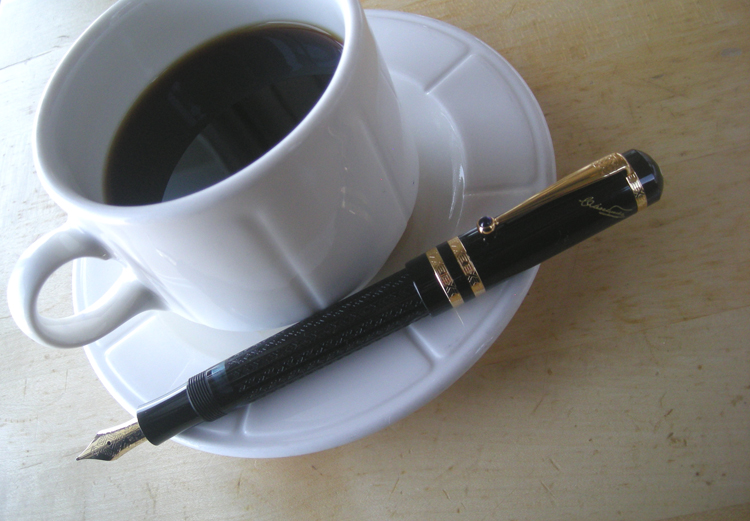 For some years now, I have recognised that quality and aesthetics are extremely important to me, and that I enjoy owning, using and collecting certain things very much - to the extent that I am quite willing to sacrifice other things in my life to have them. What was necessary, I realised, was simply to identify those items or activities I would be willing to sacrifice. Perhaps there were all sorts of things I was including in my lifestyle out of habit that did not need to be there. If I could endure going without them, it would free up funds for the things I had always dreamed of. So these are the areas of my life where I save in order to afford the things I truly want:
For some years now, I have recognised that quality and aesthetics are extremely important to me, and that I enjoy owning, using and collecting certain things very much - to the extent that I am quite willing to sacrifice other things in my life to have them. What was necessary, I realised, was simply to identify those items or activities I would be willing to sacrifice. Perhaps there were all sorts of things I was including in my lifestyle out of habit that did not need to be there. If I could endure going without them, it would free up funds for the things I had always dreamed of. So these are the areas of my life where I save in order to afford the things I truly want: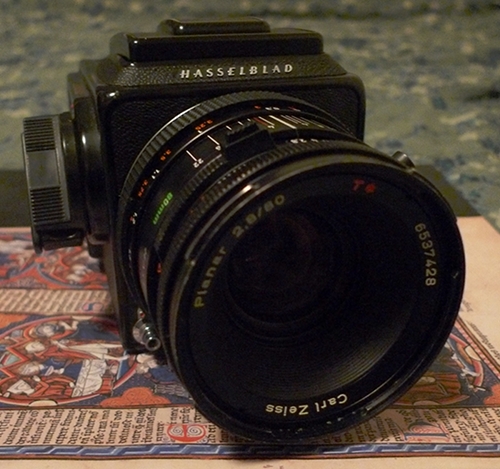 So that is my list of things I do not spend money on. The things I choose to spend money on instead include: an enormous library (really, you might be shocked to see how many books I own!), my beloved collection of fountain pens, my vintage photographic equipment, a top of the line laptop every few years, coffee (I am a hopeless addict), and now also - you guessed it - bicycles.
So that is my list of things I do not spend money on. The things I choose to spend money on instead include: an enormous library (really, you might be shocked to see how many books I own!), my beloved collection of fountain pens, my vintage photographic equipment, a top of the line laptop every few years, coffee (I am a hopeless addict), and now also - you guessed it - bicycles.  If you've been reading this weblog, you know what my answers to those questions have been. The point is, that you can choose. How much do you enjoy all the different little things in your life that you are paying for on a daily, weekly, monthly, and yearly basis? More than you would enjoy a dreamy bicycle? If not, then stop doing some of those things and use the money saved to buy that "unaffordable" bike.
If you've been reading this weblog, you know what my answers to those questions have been. The point is, that you can choose. How much do you enjoy all the different little things in your life that you are paying for on a daily, weekly, monthly, and yearly basis? More than you would enjoy a dreamy bicycle? If not, then stop doing some of those things and use the money saved to buy that "unaffordable" bike.  To ease this pathetic state, I gifted myself a "new" camera (a Rolleicord Ia circa 1941, if that means anything to you). That's the one hanging around my neck with the twin lenses. The one in my hands is a Lumix 3 digital point-and-shoot. And yes, those are bicycles behind me. Ironic, isn't it? I have
To ease this pathetic state, I gifted myself a "new" camera (a Rolleicord Ia circa 1941, if that means anything to you). That's the one hanging around my neck with the twin lenses. The one in my hands is a Lumix 3 digital point-and-shoot. And yes, those are bicycles behind me. Ironic, isn't it? I have 






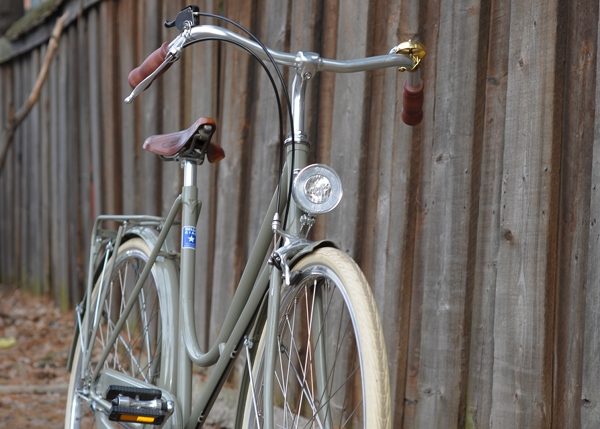 When I showedthese picturesearlier, some of you noticed that the cork grips matched the bicycle's saddle and I explained that the grips were stained. Now I've done the same to mywooden grips, and will take this opportunity to describe the process for those interested.
When I showedthese picturesearlier, some of you noticed that the cork grips matched the bicycle's saddle and I explained that the grips were stained. Now I've done the same to mywooden grips, and will take this opportunity to describe the process for those interested. Where to buyand what kind?You can buy a small can of wood stain at any hardware store. There are many different kinds to choose from, all of which should work on both cork and wooden grips. I suggest choosing a stain that is oil-based, not water-based or synthetic. Oil-based stains permeate better, look more natural, and are more fade-resistant.
Where to buyand what kind?You can buy a small can of wood stain at any hardware store. There are many different kinds to choose from, all of which should work on both cork and wooden grips. I suggest choosing a stain that is oil-based, not water-based or synthetic. Oil-based stains permeate better, look more natural, and are more fade-resistant.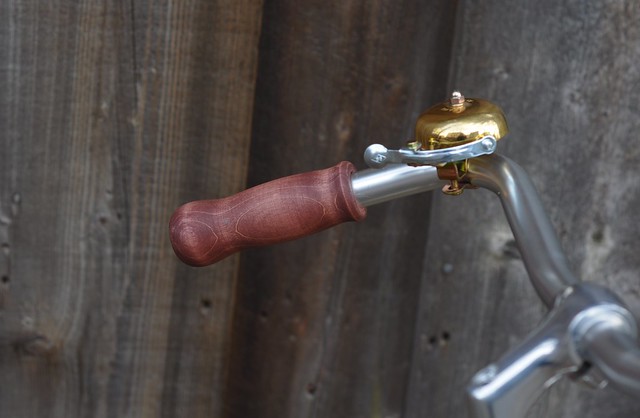 Applying wood stainOil-based stains require ventilation, so you will need to apply the stain in front of an open window or outdoors. Stir the stain inside the container very thoroughly, as the pigment tends to separate and settle on the bottom of the can. Then apply stain to the grips using an inexpensive paintbrush. Apply very thinly. The stain should not be leaking off of your grips and you should be able to see the texture of the wood or cork through it at all times - remember that it's more like a dye than a paint: slowly work it into the surface, rather than attempting to paint with it. Wipe the excess off with a napkin or rag and stand the grips to dry on a newspaper. Don't worry too much if your application doesn't look perfectly even; if anything, that complements the natural variations in the material. There is really not a whole lot you can do to mess this up.
Applying wood stainOil-based stains require ventilation, so you will need to apply the stain in front of an open window or outdoors. Stir the stain inside the container very thoroughly, as the pigment tends to separate and settle on the bottom of the can. Then apply stain to the grips using an inexpensive paintbrush. Apply very thinly. The stain should not be leaking off of your grips and you should be able to see the texture of the wood or cork through it at all times - remember that it's more like a dye than a paint: slowly work it into the surface, rather than attempting to paint with it. Wipe the excess off with a napkin or rag and stand the grips to dry on a newspaper. Don't worry too much if your application doesn't look perfectly even; if anything, that complements the natural variations in the material. There is really not a whole lot you can do to mess this up.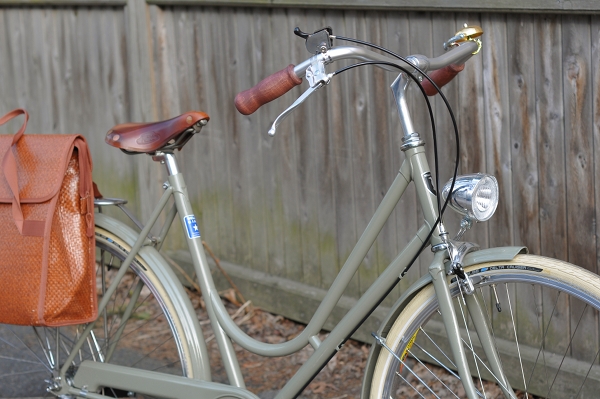 And enjoy your beautifully matching saddle and grips. A pair of plain cork grips will set you back $10, and a small container of wood stain an additional $5. It's a fun and simple way to spruce up your handlebars.
And enjoy your beautifully matching saddle and grips. A pair of plain cork grips will set you back $10, and a small container of wood stain an additional $5. It's a fun and simple way to spruce up your handlebars.





